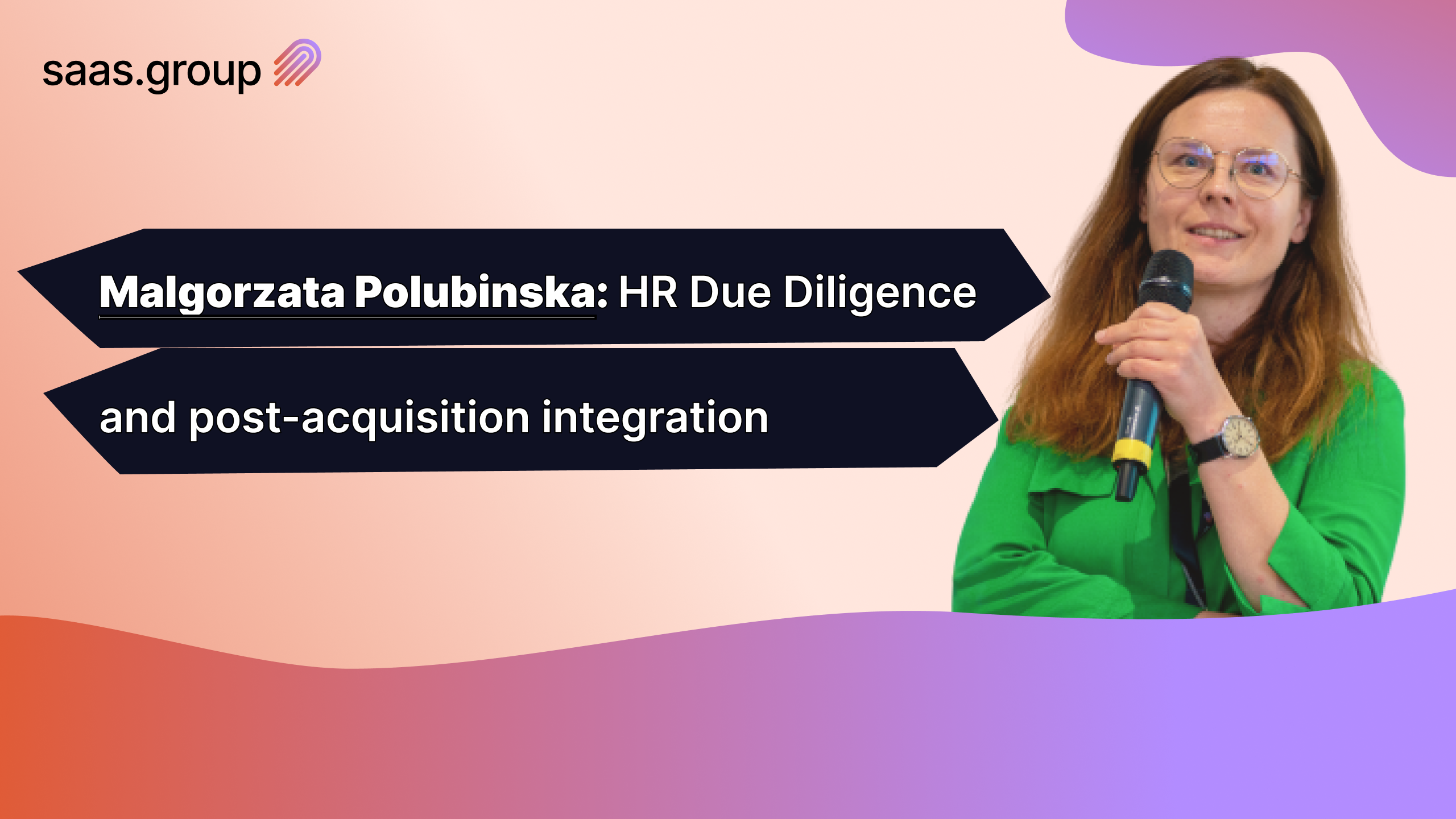Ever wondered what happens behind the scenes during HR due diligence in company acquisitions? We sat down with Malgorzata Polubinska, Head of HR at saas.group to uncover what HR processes are required during the SaaS company acquisition and what information and documentation the HR department might be looking at during the sale.
What are the usual HR data requests during due diligence?
The main objective of gathering as much information as possible is to get to know the company, their team – and how they are employed – as well as to see what HR practices are in place (if any).
We always request the contracts of all team members and all documents available, e.g. handbooks, policies, org charts, performance overviews, and recent attrition.
Once provided, we analyze the data and prepare questions for the HR interviews. Based on the employment contracts and setup, we assess the potential legal risks and define the changes to be implemented post-acquisition.
We also do the compensation analysis and see where the company stands compared to the market and if potential increases would be necessary in the near future.
Usually, the smaller the company, the less structured HR data they have.
What happens next? Is there anything else you take into consideration?
We gather some public data, e.g., I check their LinkedIn to see any employer branding activities or read their Glassdoor reviews. What is the reputation of the company? How do the current/ past employees or candidates see them? Would it have any implications for future hiring? How do they present themselves on their website? Do they have company values, and what are those? Essentially, we are assessing if there is a cultural fit for saas.group.
You mentioned the HR interviews. Can you share more? What happens during the calls?
This is always an exciting time because it’s the first interaction with potential new colleagues! We usually talk with the founders or CEOs – which could be one person.
At this point, in most cases, the team is not aware of the acquisition, so we can’t interview them. The call mostly focuses on the questions we have about the team and the documents provided.
We always ask about the culture, values, and main HR projects or challenges.
We also try to establish what the team (including the leaders) needs post-acquisition to plan internally. I’m always curious about what reactions leaders expect from their team – this also helps us prepare the best communication strategy going forward.
How to best communicate the deal with your team?
Well, we need to acknowledge that being acquired is usually a stressful event. People are unsure how this will affect their work, their lives, and the company itself. Some people are waiting for the change, and some are really stressed about it.
We believe in transparency. First of all, we openly discuss the changes with the founders or leaders and align on those before the acquisitions This might include a tough decision of reducing the team or, on the contrary, a hiring plan for the next few months, closing or downsizing the office, etc. Then we create a plan and communicate it openly to the team.
I really think transparency is the key here. If we commit to something, we need to keep the promise. This approach builds trust in the leaders from both sides—the acquired company and saas.group.
We usually have an All Hands session when we explain why we acquired the company (and why the founders sold it), how we work at saas.group, and what immediate or long-term changes should be expected. During this session, we’re ready to answer any questions that could pop up and explain anything that could be of interest.
What are the usual changes teams can expect after the acquisition?
The short answer: it depends. Usually, the changes mostly concern the leader or leaders of the company. They now have responsibilities to report to our Board, but they also gain like-minded and talented peers to share their ideas and support each other. We actually aim to connect functional teams across our portfolio so they can share experiences and best practices.
The leader of the company is still responsible for general performance, the product, and their people. Of course, if we need to let some people go, we might need to change some of the responsibilities of the team members, decide to deprioritize projects or stop something completely.
How often does downsizing happen?
It really depends on the team and the future needs. We made a couple of successful acquisitions where we needed to downsize the team. We also know that some teams are growing in an unsustainable way.
It’s always tough to say goodbye to colleagues. We need to assess what kind of team would run the company efficiently and profitably and see if all the people are utilized.
In some cases, the teams were preparing to grow rapidly, which either didn’t happen at all or they grew below expectations, so they have team members who are also needed in a very limited capacity. We need to have an open discussion with the sellers and align on the terminations before the acquisition. We also had some cases when we offered central roles for the team members. I have 2 people on my team who came to us through acquisitions. We were able to keep their jobs and actually provide interesting career opportunities for them, expanding their role to multiple brands.
What is the process and timeline for merging HR systems?
The companies we acquire rarely have HR systems or tools. In the first weeks, we focus on helping the team navigate the company. So we make sure Slack is integrated so that people can see the information about saas.group in Notion and can educate themselves.
This is when we encourage the teams to connect and start the exchange. We run some workshops to gather feedback and current needs. We also run post-acquisition surveys to see how the team perceives the change and if something needs to be addressed immediately. We encourage new teams to participate in our feedback cycles, but it’s always the decision of the leader when and if to participate. Usually, it takes several months to integrate all the processes.
When it comes to saas.group’s process, are there many changes that teams are facing?
From an operational perspective, the majority of the internal processes stay the same. What I notice are two approaches:
1. the team needs more structure (e.g. a feedback cycle or regular compensation updates)
2. the team wants to continue with their way of working.
We trust the teams with the decision to opt in or out. We prefer to act as advisors and not force them. Of course, there are some HR compliance topics we need to observe and work on with the team to implement changes. There is no opt-out for those.
What is the most challenging part of post-integration?
It’s sometimes challenging to clearly explain how we work as a company. Our setup is somehow unusual.
The second one is to manage the emotional part of the acquisition for the team. I think it’s crucial for the leaders to define the direction in which the company is going and to communicate it clearly with the team, clarifying who is responsible for what. It’s also super important for us as central teams to keep the promise in terms of hands-on support and advisory. But, all in all, we all have the same goal!
So, there you have it. The HR due diligence process during an acquisition is a complex journey, but we’re at saas.group doing everything to bring transparency to it.
If you want to learn more about technical due diligence or the overall strategy of saas.group acquiring companies, check out our blog posts about it. If you’re thinking about the potential sale of your company, reach out to start a conversation about how we can fit into your unique story.
Table of Contents
Weekly newsletter
No spam. Just the latest news and articles from the world of SaaS and Acquisitions.




